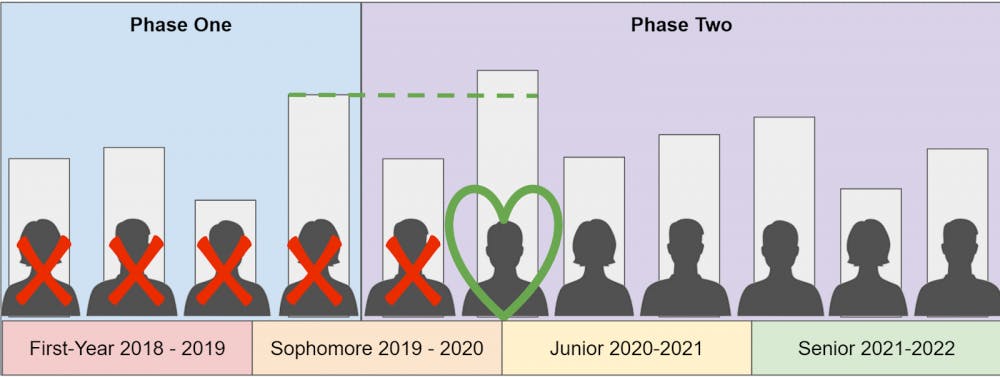For first-years at Duke, stress comes in various forms: making friends, struggling in class, missing the bus. For many of these novel pressures, Duke attempts to provide some feeble remediation. But for perhaps the most stressful of all—finding love—even Duke can provide no help.
From first-year move-in to commencement, you have around 1,352 days to find the best possible person to start your Duke romance with. But finding love, especially mathematically optimal love, is no small feat. Settle down too early, and end up missing out on an even better future partner. Wait too long, and all your best suitors may already be taken. You may try your luck at Shooters—but rarely can one find oneself among the sweat and iniquity there, let alone their one true love. Or you may take your chances on a dating app—but those become easily saturated and still don’t solve the problem of who to choose.
Luckily for you, mathematics provides a straightforward solution: for the first 37 percent of your Duke career, don’t fall in love. You can achieve the greatest verifiable odds of finding your perfect match—all you have to do is follow dating advice from a mathematician.
Through the centuries this problem has come in many forms: “the secretary problem,” “the sultan’s dowry problem” and most recently as “optimal stopping theory.” The mathematical phenomenon was popularized when Martin Gardner wrote about it in Scientific American in 1960 and has since inspired research in economics, finance, biology, and statistics. The 37 percent rule it generated has been found everywhere from fish mating behavior to choosing optimal toilets at music festivals. And now the power of optimal stopping theory is going to help you find the perfect partner at Duke. It works in two phases.
During the first phase, call it the rejection phase, you cannot fall in love. Always keep track of the best person you’ve met, but it is imperative that you keep moving. For the first 37 percent of your time at Duke—500.2 days—your only goal is to establish your baseline. You can have flings, go on dates and swipe on Tinder, but you cannot fall in love. No matter how intelligent, compatible or great of an investment banker you think they may be, you must leave them behind during the rejection phase. You must resist the urge of love until Thursday, January 3rd, 2020 around 4:48 AM, just before the start of your sophomore spring. That’s when you’ll enter phase two.
During this second phase, call it the commitment phase, your strategy is simple: continue to play the field until you find the first person who is better than the best person you met during the 500.2 days of the rejection phase. This lucky contestant has the highest probability, out of everyone that came before them and may come after them, of being your optimal Duke partner. At this point, you need only convince them to date you—which is coincidentally where optimal stopping theory and I run out of advice.
Sure, this method does not come without risks. For example, in the commitment phase, you may not find someone better than the best person you’ve discarded during the rejection phase. In this case, you’ll have to try again out in the wild of the real world or try to return to them and explain your miscalculation. Worse still, citing rigorous mathematics for your break-up may get you into some trouble during your first 500.2 days at Duke. On the other hand, I could not cook up a more quintessentially Duke reason for ending a relationship.
Despite all its potential pitfalls, this method for finding love is the best we have to work with—so first-years, don’t fall in love. In some ways this advice may match the conventional wisdom, and in others, its operationalization may seem impractical. But, I hope that aside from its practicality, this bit about the mathematics of love may persuade you to have a bit more love for mathematics.
Luke Farrell is a Trinity senior and requests that you don’t cite him when working through your rejection phase. His column, By The Numbers, runs biweekly on Thursdays.
Get The Chronicle straight to your inbox
Signup for our weekly newsletter. Cancel at any time.

